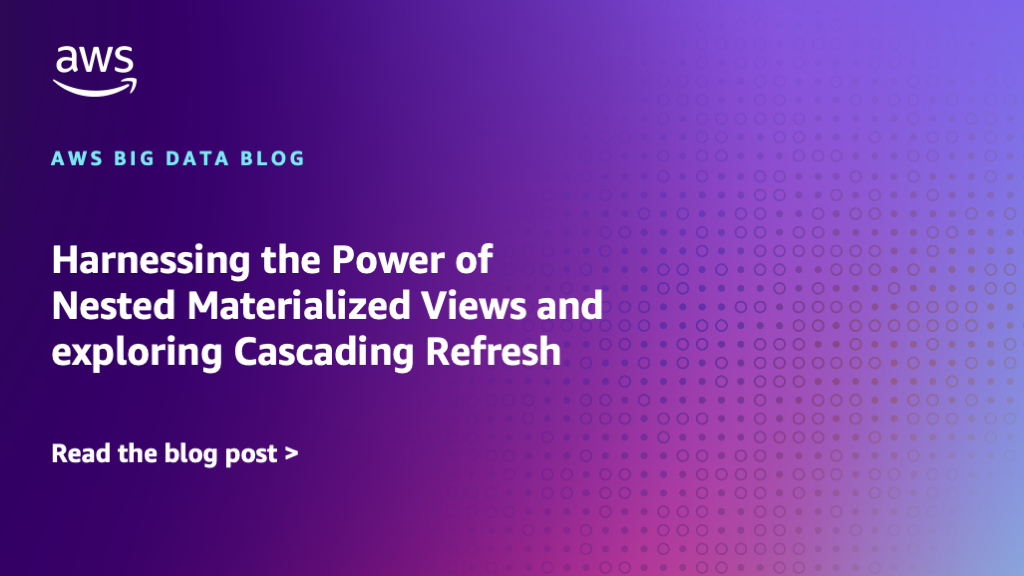AWS Big Data Blog
Tag: Amazon Redshift
Secure generative SQL with Amazon Q
In this post, we discuss the design and security controls in place when using generative SQL and its use in both Amazon SageMaker Unified Studio and Amazon Redshift Query Editor v2.
Harnessing the Power of Nested Materialized Views and exploring Cascading Refresh
In this post, we explore how to maximize Amazon Redshift query performance through nested materialized views and implementing cascading refresh strategies. We demonstrate how to create materialized views based on other materialized views, enabling a hierarchical structure of precomputed results that significantly enhances query performance and data processing efficiency, particularly useful for reusing precomputed joins with different aggregate options.
Build a multi-Region analytics solution with Amazon Redshift, Amazon S3, and Amazon QuickSight
This post explores how to effectively architect a solution that addresses this specific challenge: enabling comprehensive analytics capabilities for global teams while making sure that your data remains in the AWS Regions required by your compliance framework. We use a variety of AWS services, including Amazon Redshift, Amazon Simple Storage Service (Amazon S3), and Amazon QuickSight.
Scalable analytics and centralized governance for Apache Iceberg tables using Amazon S3 Tables and Amazon Redshift
In this post, we’ll build on the first post in this series to show you how to set up an Apache Iceberg data lake catalog using Amazon S3 Tables and provide different levels of access control to your data. Through this example, you’ll set up fine-grained access controls for multiple users and see how this works using Amazon Redshift. We’ll also review an example with simultaneously using data that resides both in Amazon Redshift and Amazon S3 Tables, enabling a unified analytics experience.
Configure cross-account access of Amazon SageMaker Lakehouse multi-catalog tables using AWS Glue 5.0 Spark
In this post, we show you how to share an Amazon Redshift table and Amazon S3 based Iceberg table from the account that owns the data to another account that consumes the data. In the recipient account, we run a join query on the shared data lake and data warehouse tables using Spark in AWS Glue 5.0. We walk you through the complete cross-account setup and provide the Spark configuration in a Python notebook.
Unlock the power of optimization in Amazon Redshift Serverless
In this post, we demonstrate how Amazon Redshift Serverless AI-driven scaling and optimization impacts performance and cost across different optimization profiles.
Ingest data from Google Analytics 4 and Google Sheets to Amazon Redshift using Amazon AppFlow
Amazon AppFlow bridges the gap between Google applications and Amazon Redshift, empowering organizations to unlock deeper insights and drive data-informed decisions. In this post, we show you how to establish the data ingestion pipeline between Google Analytics 4, Google Sheets, and an Amazon Redshift Serverless workgroup.
Building end-to-end data lineage for one-time and complex queries using Amazon Athena, Amazon Redshift, Amazon Neptune and dbt
In this post, we use dbt for data modeling on both Amazon Athena and Amazon Redshift. dbt on Athena supports real-time queries, while dbt on Amazon Redshift handles complex queries, unifying the development language and significantly reducing the technical learning curve. Using a single dbt modeling language not only simplifies the development process but also automatically generates consistent data lineage information. This approach offers robust adaptability, easily accommodating changes in data structures.
Federate to Amazon Redshift Query Editor v2 with Microsoft Entra ID
In this post, we explore the process of federating into AWS using Microsoft Entra ID and AWS Identity and Access Management (IAM), and how to restrict access to datasets based on permissions linked to AD groups. We guide you through the setup process, and demonstrate how to seamlessly connect to the Redshift Query Editor while making sure data access permissions are accurately enforced based on your Microsoft Entra ID groups.
How Getir unleashed data democratization using a data mesh architecture with Amazon Redshift
In this post, we explain how ultrafast delivery pioneer, Getir, unleashed the power of data democratization on a large scale through their data mesh architecture using Amazon Redshift. We start by introducing Getir and their vision—to seamlessly, securely, and efficiently share business data across different teams within the organization for BI, extract, transform, and load (ETL), and other use cases. We’ll then explore how Amazon Redshift data sharing powered the data mesh architecture that allowed Getir to achieve this transformative vision.









